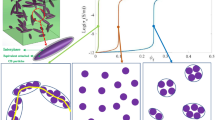Abstract
It is known that the electrical volume resistivity of insulating polymers filled with conductive fillers, such as metal particles and/or carbon black (CB) particles, suddenly decreases at a certain content of the filler. Therefore, it is very difficult to control the resistivity in the semiconductive region for the CB-filled composites. We examined two effects to control the electrical volume resistivity in the semiconductive region for CB-filled polymer composites. One is the effect of fluorination of the CB surface on the percolation behavior using surface-fluorinated CB particles as a filler. The other is the effect of copolymerization of polyethylene (PE) with a vinyl acetate (VA) functional group on the percolation behavior using poly(ethylene-co-VA) (EVA) as a matrix. By immersion heat measurements, it was found that the London dispersive component turned out to be the predominant factor of the surface energy of fluorinated CBs. The London dispersive component of the surface energy significantly decreased, while the polar component slightly increased on increasing the fluorine content. The resistivity of fluorinated a CB-filled low-density PE composite showed that the percolation threshold increased, and the transition from the insulating state to the conductive state became sluggish, on increasing the fluorine content. In the case of using EVA as a matrix, on the other hand, the percolation curve was moderated with the increase in the VA content. Therefore, copolymerization of PE with VA is also suitable for the design of a semiconductive polymer composite as well as for fluorination of the CB surface. The total surface area per unit mass of dispersed CB particles in the EVA matrix estimated from small-angle X-ray scattering decreased with increasing CB content. Further, the decrease in the surface area is moderated with an increase in VA content. It was found that the difference in the percolation curve is due to the difference in the dispersive state of CB particles.






Similar content being viewed by others
References
Buche FJ (1972) Appl Phys 43:4837
Buche FJ (1973) Appl Phys 44:532
Miyasaka K, Watanabe K, Jojima E, Aida H, Sumita M, Ishikawa K (1982) J Mater Sci 17:1610
Sumita M, Asai S, Miyadera N, Jojima E, Miyasaka K (1986) Colloid Polym Sci 264:212
Wessling B (1988) Synth Met 27:A83
Lux F (1993) J Mater Sci 28:285
Ando N, Takeuchi M (1998) Thin Solid Films 334:182
Wu G, Zhang C, Miura T, Asai S, Sumita M (2000) J Appl Polym Sci 80:1063
Katada A, Akiyama K, Isogai T, Tominaga Y, Asai S, Sumita M (2003) Mater Sci Technol 40:35
Katada A, Konishi Y, Isogai T, Tominaga Y, Asai S, Sumita M (2003) J Appl Polym Sci 89:1151
Katada A, Isogai T, Sumita M (2003) J Soc Rubber Ind 76: 375
Rodrigues J, Hamed GR (1996) Rubber Chem Technol 69:286
Katada A, Shimura S, Tominaga Y, Asai S, Sumita M (2004) J Appl Polym Sci 91:2928
Isogai T, Maruyama S, Yamana M, Kubo M (1994) In: Annual 21st meetings of the Carbon Society. Abstract 278
Isogai T, Yamaguchi F, Kubo M (1998) Fluorine in coatings III papers. The Paints Research Association 27
Shout TR, Moffatt D, Huebner W. (1991) J Mater Sci 26:145
Xiao Y, Wu G, Ma D (1998) J Appl Polym Sci 67:131
Zhang JF, Zheng Q, Yang YQ, Yi XS (2002) J Appl Polym Sci 83:3112
Park SJ, Kim HC, Kim HY (2002) J Colloid Interface Sci 255:145
Brown DS, Warner FP, Wetton RE (1972) Polymer 13:575
Young RJ, Al-khudhairy DH, Thomas AG (1986) J Mater Sci 21:1211
Deslandes Y, Whitemore MK, Bluhm TL, Hokansson A (1988) J Dispersion Sci Technol 9:235
Zhang C, Yi XS, Asai S, Sumita M (1999) Compos Interfaces 6:28
Brunauer S, Emmett PH, Teller E (1938) J Am Chem Soc 60:309
Owens DK, Wendt RC (1969) J Appl Polym Sci 13:1741
Schonhorn H (1966) Nature 210:896
Kraus G. (1955) J Phys Chem 59:343
Tsutsumi K, Abe K (1989) Colloid Interface Sci 267:637
Gonzalez-Martin ML, Junczuk B, Labajos-Broncano L, Bruque JM (1997) Langmuir 13:5991
London F (1937) Trans Faraday Soc 33:8
Fox HW, Zisman WA (1950) J Colloid Sci 5:514
Sichel EK (ed) (1982) Carbon black polymer composites. Dekker, New York
Ezquerra TA, Kulescza M, Balta Calleja FJ (1991) Synth Met 41:915
Porod VG (1951) Kolloid Z 124:83
Porod VG (1952) Kolloid Z 125:51
Debye P, Anderson HR, Brumberger H (1957) J Appl Phys 28:679
Dawkins JV (ed) (1978) Developments in polymer characterization-1. Applied Science, London
Author information
Authors and Affiliations
Corresponding author
Rights and permissions
About this article
Cite this article
Katada, A., Buys, Y.F., Tominaga, Y. et al. Resistivity control in the semiconductive region for carbon-black-filled polymer composites. Colloid Polym Sci 283, 367–374 (2005). https://doi.org/10.1007/s00396-004-1149-5
Received:
Accepted:
Published:
Issue Date:
DOI: https://doi.org/10.1007/s00396-004-1149-5




